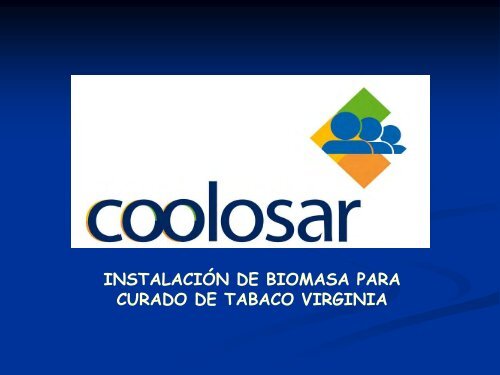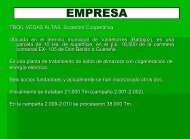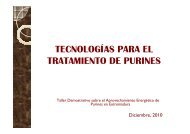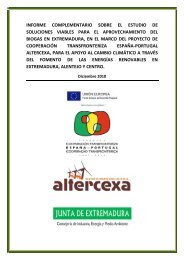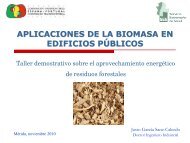Uso industrial de la Biomasa para secaderos de tabaco - Altercexa
Uso industrial de la Biomasa para secaderos de tabaco - Altercexa
Uso industrial de la Biomasa para secaderos de tabaco - Altercexa
- No tags were found...
Create successful ePaper yourself
Turn your PDF publications into a flip-book with our unique Google optimized e-Paper software.
INSTALACIÓN DE BIOMASA PARACURADO DE TABACO VIRGINIA
COOLOSAR•En 1.955 se constituye <strong>la</strong> COOPERATIVA DELCAMPO Y CAJA RURAL DE LOSAR DE LA VERA,hoy COOLOSAR, Sociedad Cooperativa Agraria.•En <strong>la</strong> actualidad contamos con 359 socios,agricultores y gana<strong>de</strong>ros, a<strong>de</strong>más <strong>de</strong> más <strong>de</strong> 100asociados.•21 trabajadores fijos y 100 en punta. (elperiodo punta son 100 a 120 días)•La facturación anual supera los 5 Millones <strong>de</strong>Euros, sin contar con <strong>la</strong>s producciones <strong>de</strong> lossocios
COOLOSAR•Coolosar se organiza en cuatro seccionesperfectamente diferenciadas, a<strong>de</strong>más <strong>de</strong> participarmayoritariamente en Fertilizantes Tabablend, S. L.SECCIÓN DE CRÉDITOSECCIÓN TABACOSECCIÓN GANADERASECCIÓN AGRÍCOLA
SITUACIÓN INICIAL DE LAS EXPLOTACIONES•Explotaciones atomizadas•Escasa capacidad <strong>de</strong> mo<strong>de</strong>rnización•Seca<strong>de</strong>ros obsoletos•Capacidad <strong>de</strong> curado sin control•Curvas <strong>de</strong> curado dispares y sin control•Costes <strong>de</strong> producción elevados
SITUACIÓN INICIAL DE LOS SECADEROS•Edad media superior los 15 años•Ais<strong>la</strong>nte <strong>de</strong> poliuretano a <strong>la</strong> vista, aunquese estaban reformando•Combustible utilizado: Gasoil o Propano•Llenado en ban<strong>de</strong>jas, sin control en elpeso <strong>de</strong> entrada <strong>de</strong> <strong>tabaco</strong> ver<strong>de</strong>
SITUACIÓN INICIAL DE LOS SECADEROS
MOTIVOS•Presión por parte <strong>de</strong> <strong>la</strong>s empresas en cuanto a<strong>la</strong> presencia <strong>de</strong> materias extrañas (poliuretano) y<strong>para</strong> tratar <strong>de</strong> bajar los niveles <strong>de</strong> nitrosaminas•Elevados costes <strong>de</strong> recolección, combustibles,electricidad, etc•Mejorar <strong>la</strong> competitividad <strong>de</strong> <strong>la</strong>s explotaciones•Posiblemente <strong>la</strong> única oportunidad <strong>para</strong> que <strong>la</strong>spequeñas explotaciones continúen en el negocio
EL PROYECTO•2.006. Se inicia un proyecto <strong>de</strong> mecanizaciónconjunta <strong>para</strong> <strong>la</strong> recolección <strong>de</strong> <strong>tabaco</strong> virginia•2.007. Se duplica <strong>la</strong> mecanización conjunta y seinicia <strong>la</strong> 1ª Fase <strong>de</strong> <strong>la</strong> P<strong>la</strong>nta <strong>de</strong> Curado (24Seca<strong>de</strong>ros)•2.008. Se construye <strong>la</strong> 2ª Fase <strong>de</strong> <strong>la</strong> P<strong>la</strong>nta <strong>de</strong>Curado (96 Seca<strong>de</strong>ros)•2.010. Se construye <strong>la</strong> 3ª Fase <strong>de</strong> <strong>la</strong> P<strong>la</strong>nta <strong>de</strong>Curado (64 seca<strong>de</strong>ros)
EL PROYECTO•184 seca<strong>de</strong>ros <strong>de</strong> <strong>tabaco</strong> virginia•Seca<strong>de</strong>ro: 9 contenedores con una capacidad enseco <strong>de</strong> 700 a 1.500 kg <strong>de</strong> <strong>tabaco</strong> por hornada(<strong>de</strong> 12 a 14 hornadas por campaña)•Capacidad total <strong>de</strong> 2,3 a 2,5 mill <strong>de</strong> kg <strong>de</strong><strong>tabaco</strong> en rama, más <strong>de</strong>l 95% <strong>de</strong>l <strong>tabaco</strong> <strong>de</strong> <strong>la</strong>cooperativa.•10 cal<strong>de</strong>ras <strong>para</strong> biomasa <strong>de</strong> 1,5 mill <strong>de</strong> kcal y2 <strong>de</strong> 1,25 mill kcal, con una potencia total <strong>de</strong>20.346 kw.•Insta<strong>la</strong>ciones <strong>para</strong> <strong>la</strong> recogida, llenado, curado,selección y almacén
EL PROYECTOAÑORECOLECCIÓNCURADOTOTAL2006 320.000 0 320.0002007 320.000 985.000 1.305.0002008 74.500 3.850.000 3.924.5002009 0 0 02010 450.000 3.500.000 3.950.000T0TAL 1.164.500 8.335.000 9.499.500
FUNCIONAMIENTO•Cada explotación tiene una “cuota <strong>de</strong>curado” por ciclo <strong>de</strong> 8 días•El agricultor “entrega” el <strong>tabaco</strong> ver<strong>de</strong> yahí acaba su <strong>la</strong>bor•Coolosar se encarga <strong>de</strong> todo el proceso<strong>de</strong> llenado <strong>de</strong> contenedores, carga <strong>de</strong>seca<strong>de</strong>ros, curado, selección,empaquetado, almacenaje y venta <strong>de</strong>lproducto final
RECOLECCIÓN
LLEGADA AL PATIO
DESCARGA
LLENADO DE CONTENEDORES
CARGA DE SECADEROS
SECADERO
DESCARGA DE SECADEROS
SELECCIÓN
EMPAQUETADO
ALMACÉN
VENTA
ALMACÉN DE BIOMASA
CALDERAS
ESQUEMA DE CALDERASeca<strong>de</strong>ros<strong>Biomasa</strong>Tolva <strong>de</strong>AlimentaciónCal<strong>de</strong>ra
ESQUEMA SECADEROCONTENEDORTRAMPILLACámaraVENTILADORINTERCAMBIADOR
CURVA DE CURADOGRAFICO DE TEMPERATURAS PARA SECADO DE TABACO VIRGINIATEMPERATURASAMARILLEOFIJACIÓN DE COLORSECADO DE HOJASECADO DE VENA1º FASE 2º FASE717070-71ºC5454ºC515051ºC454444ºC4241403938T.S. 38ºC39ºC41-42ºC39ºC41-42ºC44-45ºCT.H. 38ºCTEMP. AMBIENTEDE 40 A 72 HORAS, DEPENDIENDO DEL TIPO DETABACODE 5 A 10HORASDE 20 A 24 HORASDE 18 A 24 HORASHASTA EL FINAL DEL CICLONOTA: LAS SUBIDAS SIEMPRE SE REALIZARÁN A 1ºC POR HORATIEMPO
BIOMASA•Se ha usado principalmente hueso <strong>de</strong> aceituna,entero y partido, y cáscara <strong>de</strong> almendra. Losresultados obtenidos han sido muy simi<strong>la</strong>res:Durante esta campaña hemos probado con astil<strong>la</strong><strong>de</strong> forestales•Las cal<strong>de</strong>ras que usamos son <strong>de</strong> batal<strong>la</strong> ysencil<strong>la</strong>s, ya que durante 24 horas tiene queestar vigi<strong>la</strong>da toda <strong>la</strong> insta<strong>la</strong>ción•Hemos <strong>de</strong>jado <strong>de</strong> quemar más <strong>de</strong> 1.500.000 <strong>de</strong>litros <strong>de</strong> combustibles fósiles por campaña•Nos han calcu<strong>la</strong>do que hemos <strong>de</strong>jado <strong>de</strong> emitirunas 3.000 tn al año <strong>de</strong> CO2
COMPARACIÓN DE PRECIOS GASOIL-BIOMASAPrecios Combustible0,88 €0,70 €0,61 €0,75 € 0,74 €0,09 € 0,09 € 0,09 € 0,09 € 0,09 €2.007 2.008 2.009 2.010 MediaGasoil<strong>Biomasa</strong>
RESULTADOS•Gasto <strong>de</strong> Combustible fósil por kg <strong>de</strong> <strong>tabaco</strong>:0,75 kg•Precio medio <strong>de</strong>l gasoil 2.007 – 2.0100,74 €•Coste <strong>de</strong>l combustible por kg <strong>de</strong> <strong>tabaco</strong>0,5550 €
RESULTADOS: DATOS (medio campañas 08 y 09)•Gasto <strong>de</strong> <strong>Biomasa</strong> por kg <strong>de</strong> <strong>tabaco</strong>:1,65 kg•Precio medio <strong>de</strong> <strong>Biomasa</strong> 2.007 – 2.0100,09 €•Coste <strong>de</strong>l combustible por kg <strong>de</strong> <strong>tabaco</strong>0,1485 €
RESULTADOS: DATOS (medio campañas 08 y 09)•Ahorro por kg <strong>de</strong> <strong>tabaco</strong> en combustible: 0,40 €•Reducción <strong>de</strong> costes <strong>de</strong> combustible: 80 %•Reducción <strong>de</strong> costes <strong>de</strong> curado: 30 a 35 %•Reducción sobre costes <strong>de</strong> producción: 20 a 25 %
RESULTADOS: DATOS (medio campañas 08 y 09)Ahorro por kg <strong>de</strong> <strong>tabaco</strong> encombustible supone aproximadamenteel 70 % <strong>de</strong> los Costes <strong>de</strong>Amortización y Financieros <strong>de</strong> <strong>la</strong>P<strong>la</strong>nta <strong>de</strong> Curado
INSTALACIÓN DE BIOMASA PARACURADO DE TABACO VIRGINIA


